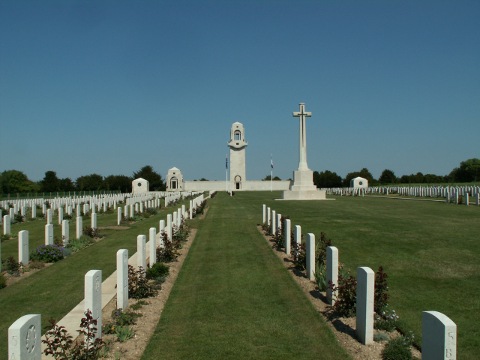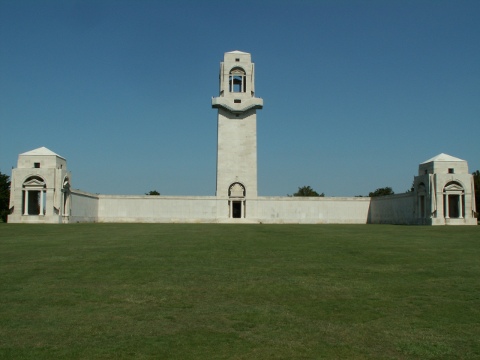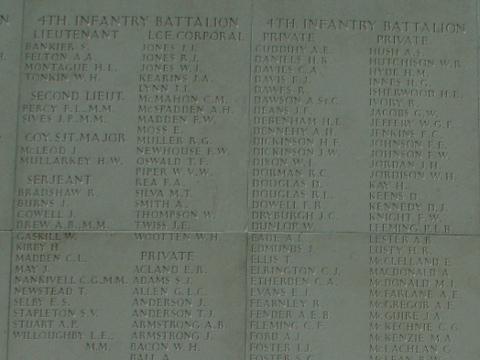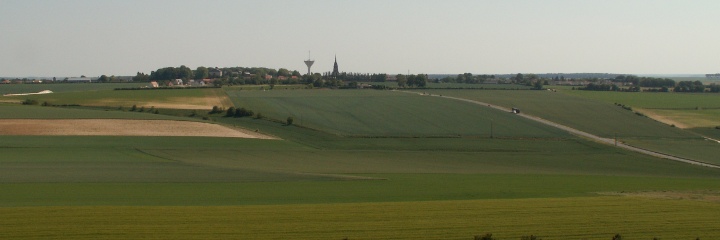Australian Memorial
Location
Villers-Bretonneux is a village 16 kilometres east of Amiens on the straight main road to St Quentin (The N 29). The Memorial stands in Villers-Bretonneux Military Cemetery, which is about 2 kilometres north of the village on the east side of the road to Fouilloy.
The Memorial is extremely well sign posted from all directions and is also highly visible for some distance.
From the N 29 turn northwards following the signs from the centre of the village. From Pozières follow the signs for Corbie. There take the road therough the town following the signs for Fouilloy turning left just at the junction to head up this hill. (All names ending in -oy in French are pronounced -wah so if asking it is Foo-ee-wah)

Historical Information
Villers-Bretonneux became famous in 1918, when the German advance on Amiens ended in the capture of the village by their tanks and infantry on 23 April.
On the following day, the 4th and 5th Australian Divisions, with units of the 8th and 18th Divisions, recaptured the whole of the village and on 8 August 1918, the 2nd and 5th Australian Divisions advanced from its eastern outskirts in the Battle of Amiens.
Australian Memorial

The Villers-Bretonneux Memorial is the Australian National Memorial erected to commemorate all Australian soldiers who fought in France and Belgium during the First World War, to their dead, and especially to those of the dead whose graves are not known.

10 700 Names
The 10,700 Australian servicemen actually named on the memorial died in the battlefields of the Somme, Arras, the German advance of 1918 and the Advance to Victory.
The memorial was unveiled by King George VI in July 1938.
Both the cemetery and memorial were designed by Sir Edwin Lutyens.
Unlike some memorials where it is necessary to check for a panel, the simple numbering of Australian units makes finding a name relatively simple. The Artillery and Cavalry come first with the Infantry battalions in their numerical order following. The memorial is read from left to right.
Anzac Day Commemorations

Looking down on the Military Cemetery from the tower
Every year on the Saturday closest to Anzac Day (25th April) the local community hold a ceremony here to remember the fallen and in particular those who liberated their village on the 25th April 1918.
This ceremony is followed by one in the village at the French Memorial and another in the afternoon at the village of Bullecourt in Artois.

Corporal John Rood MSM, Australian Light Horse
Corporal John Rood MSM 1215
2nd Light Horse Regiment
Died on 8th April 1919 aged 29
Son of Mrs Marguerite Rood, McWhae Avenue, East St Kilda, Victoria
John Rood joined the 29th Bn Australian Infantry on the 8 July 1915 at Melbourne. In 1917 he was promoted to Acting Corporal (without pay).
The 29th were one of those that had been raised in the aftermath of Gallipoli so Rood would have had a good idea that the war was going to be a bloody affair. They arrived in France via Egypt in time for the battle of Fromelles on 19th July 1916.
The 29th was so badly mauled during 1918 that it was disbanded on the 12 October 1918 with the soldiers being sent to other units.
His records show that he had a clean disciplinary record and had received the Meritorious Service Medal in recognition of his: valuable services rendered with the Armies in France and Flanders.
He left England in February 1919 en route for Australia.
According to the records of HMT Anchises Rood was disembarked at Melbourne on the 17th April 1919: yet he never returned home.
A long military enquiry decided in May 1920 that he had last been seen on board the Transport at Albany in Western Australia during a disembarkation of troops on the 7th April 1919. The findings were that he had not left the ship but had remained on board. That was the last time that anybody could remember seeing him. He was not present on the 8th and the decision of the enquiry was that he had been lost overboard and drowned on either the 7th or 8th April 1919. No suggestion was ever made as to how he might have entered the water.
Rather unusually he does not appear on the Memorial Register.
One of Australia's Heroes

In remembrance of my great uncle, Simon Fraser
Max Cameron, Port Fairy, Victoria
2nd Lieutenant Simon Fraser
58th Bn Australian Infantry
Died on 12th May 1917 aged 40
Son of James and Mary Fraser. Born at Byaduk, Victoria
It was an act of heroism at the battle of Fromelles in 1916 that caught public imagination and resulted in the depiction of the then Sergeant Fraser carrying a wounded soldier as the monument to Australian fallen at that site.
 The Cobber Memorial Fromelles
The Cobber Memorial Fromelles

Sergeant Simon Fraser at Fromelles

Looking towards Villers Bretonneux
 ANZAC 2008
ANZAC 2008
 Villers-Bretonneux Military Cemetery
Villers-Bretonneux Military Cemetery
 Villers-Bretonneux
Villers-Bretonneux
 Bullecourt
Bullecourt





